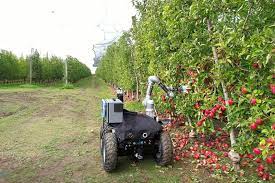Harvesting Robot Leading Sustainable Agriculture
A higher
need for effective and sustainable agricultural practices has arisen due to the
expanding global population and rising food production needs. The expanding use
of harvesting robots is one sector that has shown substantial advancement. As a
result, these robots are growing in popularity because they provide benefits
like improved efficiency, accuracy, and lower labor costs. In this blog, let's
understand the about the harvesting robot.
The use of intelligent agricultural practices has expanded substantially because of the rising need for food security and the need to raise agricultural production to meet the demands of a growing global population. Therefore, this factor predicts the market growth. In addition, according to a research report by Astute Analytica, the Global Harvesting Robot Market is likely to grow at a compound annual growth rate (CAGR) of 21.8% over the projection period from 2023 to 2031.
The most
prevalent kinds of harvesting robots
A variety of
robot kinds are employed in the agricultural sector, each with a unique set of
capabilities and functions. Harvesting robots of the most prevalent varieties
include
Automatic
Tractors: Farmers
can employ autonomous tractors for jobs requiring accuracy and regularity, like
planting, fertilizing, and spraying. They can go around fields independently
and without human drivers due to mapping technologies and GPS. The ability of
autonomous tractors to work continuously, improving productivity and lowering
labor costs, is one benefit of their use in agriculture. They are also capable
of running at a constant pace and maintaining a constant application rate,
which results in more uniform crop growth and higher yields.
FFRobotics: 10,000 apples are collected each
hour by the robot FFRobotics. This robot
machine features a three-fingered clutch that can grasp and rotate fruit from a
branch in addition to having a minimum of twelve robotic arms. FFrobot picks
fruit from trees using sophisticated algorithms, just like many other robots.
Six-Axis
Robots: The
agricultural sector uses six-axis robots, sometimes known as articulated
robots, for a variety of tasks. These robots have flexible arms with several
joints that enable them to move in many different directions and access a
variety of places.
Trends in
current automation in harvesting robot
The
industry's current automation trends are mostly focused on sustainability,
building more reliable automation systems, and using data-driven insights to
enhance outcomes. The usage of autonomous vehicles, including drones and
autonomous tractors, is growing, which is the most obvious trend.
The creation
of robotic devices that can complete various activities, including planting,
fertilizing, and spraying, in a single pass is another trend. These
multi-tasking robots provide more efficiency and eliminate the need for
numerous pieces of machinery and intensive labor.
Using data-driven decision-making more frequently in agriculture is a third trend. Robots with cameras and sensors may gather information on soil moisture, plant health, and other aspects, which can then be analyzed to help crop managers make informed decisions. Farmers can choose when to water, fertilize, and harvest their crops with greater knowledge thanks to this trend, which promotes more sustainable and effective farming practices.

Comments
Post a Comment